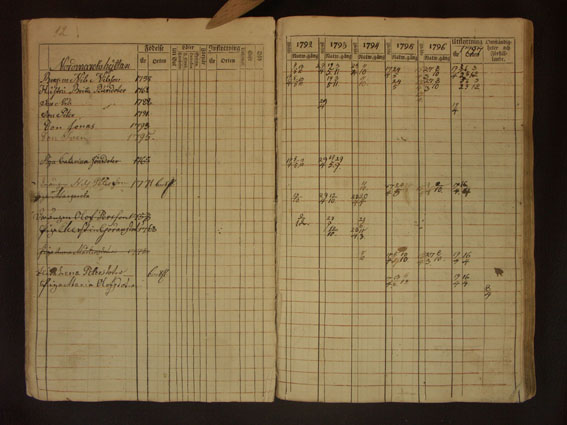
Sweden, a country in northern Europe, has not had any civil registration of Vital Statistics until 1991. Why? Did Swedes and Finns (until 1809) not have to register Births, Marriages and Deaths?
Indeed, they certainly had to, and omission to do so was punished by law. But it was not the local civilian government agencies that kept track of the important happenings in the lives of the Swedes.
It was the church. In 1527 Sweden became a Lutheran country, and the church became a State church. The king (or queen) was the head of the church until 2000, and all clergymen were also state officials, and still are in some cases. The Church of Sweden is now an idnependent organization.
The State church excluded all other denominations until 1858, and everybody had to accept to be registered by the State church, even if you were Moslem, up to 1991, when the local tax authorities took over this job.
The clergy had to keep track of the christenings, marriages and burials, to make sure the people of their parish payed the required fees for the clerical services, and also the tithes, as they had to. So accounts (kyrkoräkenskaper) are the oldest church records still existing, even some from catholic days in the 1400s.
During the early 1600s many Swedes studied at the German universities and brought home ideas on many things, which were then used in their parishes. Among those ideas was the keeping of Christening, Marriage and Burial records in a special book. This was ordered by at least two early bishops, Johannes Rudbeckius of Västerås and Johannes Botvidi of Linköping, that it should be done in their dioceses. So several parishes in those dioceses have continous Church records from about 1630 to 1991.
As a general rule, however, most Church records start in the 1680s, as a result of the Church Law of 1686.
But the keeping of Christening, Marrriage and Burial records is nothing unique for Sweden and Finland, but we do have something unique in our records: The Husförhörslängderna, or translated into English Household Examination Rolls or shorter: Clerical surveys.

Click here for a view of the lefthand page, or here for a view of the righthand page.
Here is an example of a couple of pages in a husförhörslängd from the 1790s. Everybody over the age of 15 (about) had to go to a meeting once a year, when they were examined in the knowledge of their religion. Everybody should be able to read the Cathechism, so most Swedes, even the women, could read in the early 1700s, and some even write. You had to pass the examination, or else you were not allowed to take part of the Holy Communion, and that made you a social outcast, and you were not allowed to marry, for instance.
To keep track of the parishioners' knowledge of religion, the parish priest made lists of all persons in the parish, household by household, with spaces for entering age, place of birth, moves, inoculations, knowledge of different parts of the cathechism and many other facts of life.
These records were kept continously, in big books, every volume covering mostly a period of five to ten years. The years they start are very varying in different parts of the country, as the various dioceses had different regulations about keeping this kind of record.
In Västerås diocese there are many cl. surveys from the 1600s, in Linköping diocese they generally start around 1792 and in Lund diocese in the 1810s. The completeness of these records varies a lot, according to the interest of the clergyman to keep records, some were interested, others were not.
Around the year 1895 the name of these books was changed to församlingsböcker and no longer had information about when people went to communion or their knowledge of their religion. These matters were now considered to be private. The församlingsböcker were kept until 1991.
To find people after 1991 you have to contact the tax office (Skatteverket) in the area where the person lived.
From the previous text it may be clear that the basic unit of Swedish and Finnish genealogical research is the parish (socken, församling). But what is a parish? A parish is a geographical area, the smallest administrative unit in Sweden. All people in the same parish went to the same church, were registered in the same books, and were buried in the same churchyard.
There are also bigger units, a number of neighboring parishes formed a rural deanery (prosteri), and a number of those formed a diocese (stift), of which there are now 13 in Sweden, but generally the genealogist does not have to look for the records of those units.
Someone might wonder why Finland kept the same type of records as Sweden? It is just that before the war of 1808-1809, when Sweden was defeated by Russia, Finland was a part of Sweden, in just the same way as Småland or any other of the provinces, and had been so since at last the 1200s.
Sweden has a privacy law, that states that information younger than 70 years is private, and may not be given to anyone, unless there is a very good reason. Records older than 1937 are open and available, either as microfiche, or at the parish offices or at the Regional archives (Landsarkiven), which is the final depository for the church records.
Swedish church records are available as microfilm from the Mormon Family History Centers in the U.S. or anywhere in the world through their services. They are also available as scanned pictures through the following subscription services: Genline or the new company Arkiv Digital, which offers online pictures in color. Many of the church records can also be found at SVAR, which is a branch of the Swedish National Archives (Riksarkivet). Lately Ancestry has started to offer Swedish records and some old books.
Uppdaterad 2 december 2007
Copyright Elisabeth Thorsell